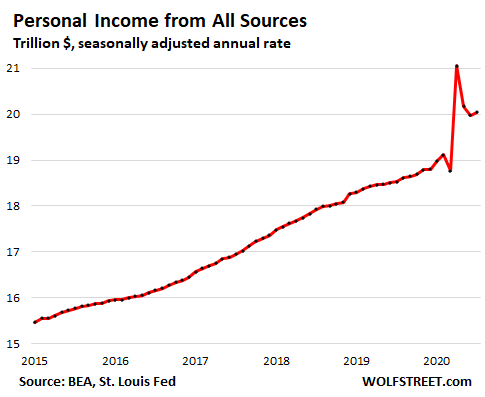On Fumes of Stimulus: California Starts Sending Out $900 Lump-Sum FEMA-Funded Unemployment Payments on Labor Day
Most states are also rolling it out. On top of other stimulus programs and housing payment deferrals via eviction bans & mortgage forbearance.
By Wolf Richter for WOLF STREET.
The stimulus party keeps rolling on. On September 7, Labor Day, the California Employment Development Department, which handles the state and federal unemployment claims for Californians, began sending out payments of $900 each to 3.1 million eligible unemployment insurance claimants. This lump-sum payment consists of three weekly $300-payments under the federal Lost Wages Assistance program, authorized by President Trump’s Executive Order, and drawing on FEMA’s Disaster Relief Fund.
This payment is in addition to the regular state or federal unemployment insurance (UI), and replaces the $600 a week in federal payments that expired at the end of July.
In its press release, the EDD said that California has received federal approval for an initial $4.5 billion in funding for a minimum of three weeks of $300-payments for “eligible claimants.” The $900-payments are sent to UI claimants that have been paid at least $100 a week on their regular UI payments received between July 26 and August 15.
There is another group of about 1.2 million claimants who can also receive the $900 lump-sum payment after they complete some final steps and “attest to their full or partial unemployment is related to the pandemic.”
The remainder of the $4.5 billion in funds might be sufficient to fund a fourth week of benefits for some of the claimants.
But the stipulation in the Executive Order that only claimants are eligible that have received at least $100 a week in benefits over the period in August renders about 192,000 of the neediest least-paid unemployment claimants in California ineligible for the federal manna, according to researchers at UCLA’s California Policy Lab.
Even with the $300 a week, total UI in California averages $575 a week, which, according to the UCLA’s report, leaves the majority of claimants receiving less than California’s poverty limit.
Thereby California becomes the latest and largest state to start sending out these additional federal unemployment funds, eventually totaling $4.5 billion.
The magnitude of UI payments has already been enormous. According to the EDD, California has already paid out $77 billion in total state and federal unemployment benefits since March 14, including $45.8 billion state UI and $28.1 billion in federal PUA (Pandemic Unemployment Assistance for the self-employed).
California is not alone. These $300-a-week payments are being rolled out across the US. But there are no guarantees that they will continue beyond three weeks; there is no further funding once the initial $44 billion in FEMA’s Disaster Relief Fund run out.
These extra $300 a week in payments form part of the enormous stimulus patchwork that has been put in place: The federal stimulus checks sent out starting in April; extra unemployment benefits under federal programs, including first the extra $600 a week and now the extra $300 a week; the PPP loans to small businesses to fund their employment even if they’re temporarily closed; and the loans and grants to large companies, such as airlines, to avoid layoffs through the end of September.
And another stimulus biggie: deferred housing costs.
Not having to make rent payments due to various eviction bans, including the new CDC eviction ban and not having to make mortgage payments due to the forbearance options allows people to spend this money on other things, such as food, a down-payment for a car, electronic gadgets, furniture, a new deck with Jacuzzi, and what not. And this has helped push up retail spending to a record in July – despite the worst unemployment crisis in a lifetime.
Stimulus falls into two categories:
Cash paid to consumers under various programs, such as stimulus checks, extra UI payments, or loans and grants to businesses that are then used to fund payroll and avoid layoffs.
Housing payment deferrals — amounts consumers don’t have to spend on housing because of eviction bans and mortgage forbearance options, though they’re just payment deferrals, not forgiveness, and add to the debt that consumers will have to deal with in the future.
The first – the stimulus and UI payments – are tracked under personal income from all sources, which in April, when the first wave of stimulus checks arrived, spiked to a record, and even in July remained far higher than any time before the Pandemic, thanks to the extra $600 a week and other support payments still in effect at the time:

The second – deferred housing payments – is a form of stimulus that is not tracked as an income item, because it is not income; it is a form of borrowing because it increases what the renter owes the landlord and what the homeowner owes the lender.
But it acts like a stimulus payment as far as retailers and service providers are concerned, where consumers end up spending this money. It shifts consumer spending from landlords and lenders to retailers and service providers. These policies create new winners and losers among businesses, and can wipe out businesses in the process. And consumers end up owing more afterwards than before.
That’s what this economy now runs on – the fumes of stimulus that could vanish at any time, and that are not sustainable, and from which any kind of exit is going to be messy.
Enjoy reading WOLF STREET and want to support it? Using ad blockers – I totally get why – but want to support the site? You can donate. I appreciate it immensely. Click on the beer and iced-tea mug to find out how:
Would you like to be notified via email when WOLF STREET publishes a new article? Sign up here.




